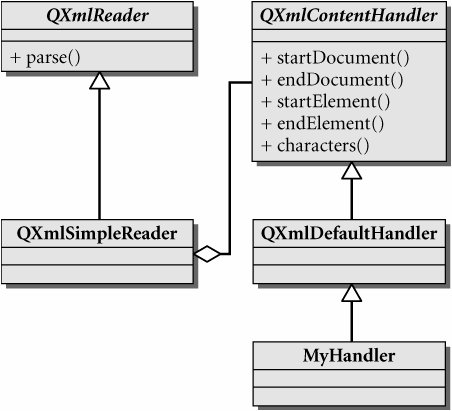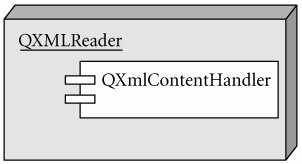Event-Driven Parsing
Working with SAX-style XML parsers means doing event-driven programming. The flow of execution depends entirely on the data that is being read from a file. This inversion of control means that the thread of execution will be more difficult to trace. Our code will be called by code inside the Qt library.
Invoking the parser involves creating a reader and a handler, hooking them up, and calling parse(), as shown in Example 14.4.
Example 14.4. src/xml/sax1/tagreader.cpp
#include "structureparser.h"
#include
#include
#include
#include
int main( int argc, char **argv ) {
if ( argc < 2 ) {
qDebug() << QString("Usage: %1 ").arg(argv[0]);
return 1;
}
for ( int i=1; i < argc; ++i ) {
QFile xmlFile( argv[i] );
QXmlInputSource source( &xmlFile );
StructureParser handler; <-- 1
QXmlSimpleReader reader; <-- 2
reader.setContentHandler( &handler ); <-- 3
reader.parse( source ); <-- 4
}
return 0;
}
|
The interface for parsing XML is described in the abstract base class QXmlContentHandler. We call this a passive interface because these methods get called, just not from our code. QXmlSimpleReader is provided, which reads an XML file and generates parse events, calling methods on a content handler in response to them. Figure 14.1 shows the main classes involved.
Figure 14.1. Abstract and concrete SAX classes

For the reader to provide any useful information, it needs an object to receive parse events. This object, a parse event handler, must implement a published interface, so it can "plug" into the parser, as shown in Figure 14.2.
Figure 14.2. Plug-in component architecture

The handler derives (directly or indirectly) from QXmlContentHandler. The virtual methods get called by the parser when it encounters various elements of the XML file during parsing. This is event-driven programming: You do not call these functions directly.
Example 14.5. src/xml/sax1/structureparser.h
#include
class QString;
class MyHandler : public QXmlDefaultHandler {
public:
bool startDocument();
bool startElement( const QString & namespaceURI,
const QString & localName,
const QString & qName,
const QXmlAttributes & atts);
bool characters(const QString& text);
bool endElement( const QString & namespaceURI,
const QString & localName,
const QString & qName );
private:
QString indent;
};
#endif
|
These passively called functions are often referred to as callbacks. They respond to events generated by the parser. The client code of MyHandler is the QXmlSimpleReader class, inside the Qt XML Module.
ContentHandler or DefaultHandler?

QXmlContentHandler is an abstract class with many pure virtual methods, all of which must be overridden by any concrete derived class. Qt has provided a concrete class named QXmlDefaultHandler that implements the base class pure virtual methods as empty do-nothing bodies. You can think of this class as a concrete base class. Handlers derived from this class are not required to override all of the methods but must override some in order to accomplish anything.
If we do not properly override each handler method that will be used by our app, the corresponding QXmlDefaultHandler method, which does nothing, will be called instead. In the body of a handler function, you can
- Store the parse results in a data structure
- Create objects according to certain rules
- Print or transform the data in a different format
- Do other useful things
See Example 14.6.
Example 14.6. src/xml/sax1/myhandler.cpp
[ . . . . ]
QTextStream cout(stdout, QIODevice::WriteOnly);
bool MyHandler::startDocument() {
indent = "";
return TRUE;
}
bool MyHandler::characters(const QString& text) {
QString t = text;
cout << t.remove('
');
return TRUE;
}
bool MyHandler::startElement( const QString&,
const QString&,
const QString& qName,
const QXmlAttributes& atts) {
QString str = QString("
%1\%2").arg(indent).arg(qName);
cout << str;
if (atts.length()>0) {
QString fieldName = atts.qName(0);
QString fieldValue = atts.value(0);
cout << QString("(%2=%3)").arg(fieldName).arg(fieldValue);
}
cout << "{";
indent += " ";
return TRUE;
}
bool MyHandler::endElement( const QString&,
const QString& ,
const QString& ) {
indent.remove( 0, 4 );
cout << "}";
return TRUE;
}
[ . . . . ]
|
The QXmlAttributes object passed into the startElement() function is a map, used to hold the name = value attribute pairs that were contained in the XML elements.
As it processes the file, the parse() function calls characters(), startElement(), and endElement() as these "events" are encountered in the file. In particular, each time a string of ordinary characters (between the beginning and end of a tag) is encountered, it's passed as an array of bytes to the characters() function.
We ran the previous program on Example 14.3 and it transformed that document into Example 14.7, something that looks a little like LaTeX, another document format.
Example 14.7. src/xml/sax1/tagreader-output.txt
section(id=xmlintro){
itle{ Intro to XML }
para{ This is a paragraph }
ul{
li{ This is an unordered list item. }
li(c=textbook){ This only shows up in the textbook } }
p{ Look at this example code below: }
include(src=xmlsamplecode.cpp){}}
|
Part I: Introduction to C++ and Qt 4
C++ Introduction
- C++ Introduction
- Overview of C++
- A Brief History of C++
- Setup: Open-Source Platforms
- Setup: Win32
- C++ First Example
- Input and Output
- Identifiers, Types, and Literals
- C++ Simple Types
- C++ Standard Library Strings
- Streams
- The Keyword const
- Pointers and Memory Access
- const* and *const
- Reference Variables
- Points of Departure
- Review Questions
Classes
- Classes
- Structs
- Class Definitions
- Member Access Specifiers
- Encapsulation
- Introduction to UML
- Friends of a Class
- Constructors
- Subobjects
- Destructors
- The Keyword static
- Copy Constructors and Assignment Operators
- Conversions
- const Member Functions
- Review Questions
Introduction to Qt
- Introduction to Qt
- Example Project: Using QApplication and QLabel
- Makefile, qmake, and Project Files
- Getting Help Online
- Style Guidelines and Naming Conventions
- The Qt Core Module
- Streams and Dates
- Points of Departure
- Review Questions
Lists
Functions
- Functions
- Function Declarations
- Overloading Functions
- Optional Arguments
- Operator Overloading
- Parameter Passing by Value
- Parameter Passing by Reference
- References to const
- Function Return Values
- Returning References from Functions
- Overloading on const-ness
- Inline Functions
- Inlining versus Macro Expansion
- Review Questions
Inheritance and Polymorphism
- Inheritance and Polymorphism
- Simple Derivation
- Derivation with Polymorphism
- Derivation from an Abstract Base Class
- Inheritance Design
- Overloading, Hiding, and Overriding
- Constructors, Destructors, and Copy Assignment Operators
- Processing Command-Line Arguments
- Points of Departure
- Review Questions
Part II: Higher-Level Programming
Libraries
- Libraries
- Code Containers
- Reusing Other Libraries
- Organizing Libraries: Dependency Management
- Installing Libraries: A Lab Exercise
- Frameworks and Components
- Review Questions
Introduction to Design Patterns
QObject
- QObject
- QObjects Child Managment
- Composite Pattern: Parents and Children
- QApplication and the Event Loop
- Q_OBJECT and moc: A Checklist
- Values and Objects
- tr() and Internationalization
- Point of Departure
- Review Questions
Generics and Containers
- Generics and Containers
- Generics and Templates
- Containers
- Managed Containers, Composites, and Aggregates
- Implicitly Shared Classes
- Generics, Algorithms, and Operators
- Serializer Pattern
- Sorted Map Example
- Review Questions
Qt GUI Widgets
- Qt GUI Widgets
- Widget Categories
- QMainWindow and QSettings
- Dialogs
- Images and Resources
- Layout of Widgets
- QActions, QMenus, and QMenuBars
- QActions, QToolbars, and QActionGroups
- Regions and QDockWidgets
- Views of a QStringList
- Points of Departure
- Review Questions
Concurrency
- Concurrency
- QProcess and Process Control
- Threads and QThread
- Summary: QProcess and QThread
- Review Questions
Validation and Regular Expressions
- Validation and Regular Expressions
- Validators
- Regular Expressions
- Regular Expression Validation
- Review Questions
Parsing XML
- Parsing XML
- The Qt XML Module
- Event-Driven Parsing
- XML, Tree Structures, and DOM
- Review Questions
Meta Objects, Properties, and Reflective Programming
- Meta Objects, Properties, and Reflective Programming
- Anti-patterns
- QMetaObject: The MetaObject Pattern
- Type Identification and qobject_cast
- Q_PROPERTY Macro: Describing QObject Properties
- QVariant Class: Accessing Properties
- DataObject: An Extension of QObject
- Property Containers: PropsMap
- Review Questions
More Design Patterns
- More Design Patterns
- Creational Patterns
- Serializer Pattern Revisited
- The Façade Pattern
- Points of Departure
- Review Questions
Models and Views
- Models and Views
- M-V-C: What about the Controller?
- Dynamic Form Models
- Qt 4 Models and Views
- Table Models
- Tree Models
- Review Questions
Qt SQL Classes
Part III: C++ Language Reference
Types and Expressions
- Types and Expressions
- Operators
- Evaluation of Logical Expressions
- Enumerations
- Signed and Unsigned Integral Types
- Standard Expression Conversions
- Explicit Conversions
- Safer Typecasting Using ANSI C++ Typecasts
- Run-Time Type Identification (RTTI)
- Member Selection Operators
- Point of Departure
- Review Questions
Scope and Storage Class
- Scope and Storage Class
- Declarations and Definitions
- Identifier Scope
- Storage Class
- Namespaces
- Review Questions
Statements and Control Structures
Memory Access
- Memory Access
- Pointer Pathology
- Further Pointer Pathology with Heap Memory
- Memory Access Summary
- Introduction to Arrays
- Pointer Arithmetic
- Arrays, Functions, and Return Values
- Different Kinds of Arrays
- Valid Pointer Operations
- What Happens If new Fails?
Chapter Summary
Inheritance in Detail
- Inheritance in Detail
- Virtual Pointers and Virtual Tables
- Polymorphism and virtual Destructors
- Multiple Inheritance
- Point of Departure
- public, protected, and private Derivation
- Review Questions
Miscellaneous Topics
Part IV: Programming Assignments
MP3 Jukebox Assignments
- MP3 Jukebox Assignments
- Data Model: Mp3File
- Visitor: Generating Playlists
- Preference: An Enumerated Type
- Reusing id3lib
- PlayListModel Serialization
- Testing Mp3File Related Classes
- Simple Queries and Filters
- Mp3PlayerView
- Models and Views: PlayList
- Source Selector
- Persistent Settings
- Edit Form View for FileTagger
- Points of Departure
Part V: Appendices
MP3 Jukebox Assignments
- MP3 Jukebox Assignments
- Appendix A. C++ Reserved Keywords
- Appendix B. Standard Headers
- Appendix C. The Development Environment
- Section C.1. The Preprocessor: For #including Files
- Section C.2. Understanding the Linker
- Section C.3. Debugging
- Section C.4. Qt Assistant and Designer
- Section C.5. Open-Source IDEs and Development Tools
Bibliography
MP3 Jukebox Assignments
EAN: 2147483647
Pages: 268
